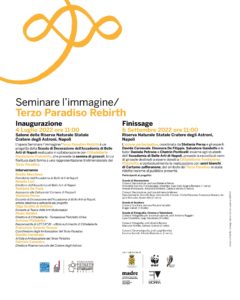Sowing the Image/Third Paradise Rebirth*, an initiative articulated through actions of environmental care, protection, redevelopment and enhancement, is a participatory project of public art transforming society, in line with the ethical and cultural instances of Michelangelo Pistoletto‘s artistic practice. The artistic-environmental project was launched by the School of Decoration of Naples’ Academy of Fine Arts with the aim of involving its students, in collaboration with Cittadellarte and with the patronage of the Municipality of Pozzuoli. As reported in one of our previous articles, Sowing the Image consists in an artistic operation carried out through the practice of sowing sunflower seeds in the area of the WWF Natural Oasis of the Astroni Crater in Naples, whose germination and growth will produce a natural installation of the symbol of the Third Paradise, thus becoming a virtuous example of environmental regeneration, as well as a source of food for insects. The project is curated by the School of Decoration of Naples’ Academy of Fine Arts in collaboration with Cittadellarte – Fondazione Pistoletto, with the patronage of the Municipality of Pozzuoli and Fondazione Morra, and the Matronage of Fondazione Donnaregina – Madre Museum in Naples, and involves artist and lecturer at the Academy Stefania Perna (click here to view our previous interview with the lecturer), who is the project referent; Davide Carnevale, Rebirth/Third Paradise ambassador; Salvatore Gandolfo and Eleonora De Filippis as experts; Chatrin Ponticelli and Daniela Petrone as tutors.
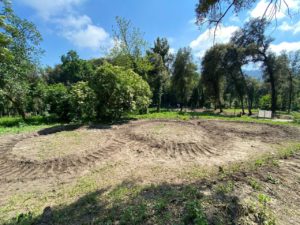

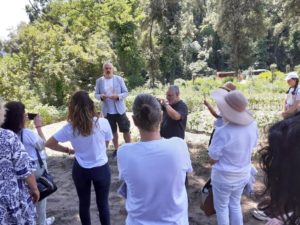
The first phase
The project is divided in three closely interdependent phases. The first phase (9-13 May 2022) involved Stefania Perna and Davide Carnevale with project experts Eleonora De Filippis and Salvatore Gandolfo and tutors Daniela Petrone and Chatrin Ponticelli from the Course of Decoration: the students from the Academy drew the symbol on the ground, creating a furrow in the earth, inside which they planted sunflower seeds (of the Sunrich Summer Provence variety), which, when flowering from the end of July, will produce the three-dimensional image of the symbol of the Third Paradise. The flowers used, chosen with respect for the ecosystem of the flora and fauna of the Astroni Crater, will also be a source of soil regeneration, forming a natural oasis of habitat for the bees and birds in the reserve. “While waiting for the plants to germinate and grow,” reads the press release, “the rebirth process has included a further action: the gift. By distributing the surplus sunflower seeds from the planting, we wanted to encourage the process of relationship and sharing characterising the principles of the Third Paradise, and the dissemination of the concept of Rebirth through involvement and empowerment in the sowing process. Each person was given two sunflower seeds (i.e. the number of seeds planted in each hole in the Astroni soil) and asked to proceed with the home planting, documenting the different stages (from sowing to flowering) following precise instructions”. This increased the participatory process, ideally reconnecting with the collective work inspired by the trinamic symbol.
The second phase
The second phase took place on 4 July 2022, with an opening that included a presentation of the project, a description of the process and a viewing of the work. For the occasion, a conference was held in Naples, featuring the following speakers: Renato Lori, Director of Naples’ Academy of Fine Arts; Stefania Perna, artist creator and referent for the project, lecturer in Decoration at the Academy; Olga Scotto di Vettimo, lecturer in Multimedia Arts Theory at the Academy; Paolo Naldini, Director of Cittadellarte; Armona Pistoletto, head of Cittadellarte’s Food Office; Francesco Saverio Teruzzi, coordinator of the Third Paradise ambassadors; Davide Carnevale, artist and Third Paradise ambassador; Fabrizio Canonico, Director of the Astroni Crater State Nature Reserve. Also present at the event were Marco Papa and Tiziana De Tora, Third Paradise ambassadors. The presence of key figures from Fondazione Pistoletto allowed the organisers and students to experience an immersive process of knowledge, which gave new inputs and ideas to enrich and delve into the experience.
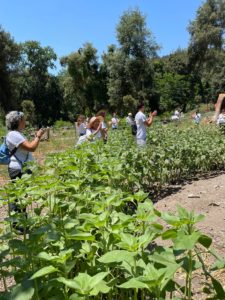

The third phase
The third and final phase, planned for 6 September, will be another participatory moment with the public as a finissage. On that occasion, a small-scale Third Paradise will be created by placing white safflower (Chartamus Tinctorius) seeds on the ground. Unlike the first phase with the sunflower seeds, these will be white seeds placed on the ground (and not sown) to form the trinamic symbol on a reduced scale, together with the public present. In addition, “the sunflowers forming the symbol of the Third Paradise will be harvested and the seeds produced by the plants preserved. In a new action of gift giving, the seeds collected will be destined to Cittadellarte, while waiting for the process of continuous regeneration of the Third Paradise to lead to new solutions of ethical and aesthetic sense”.
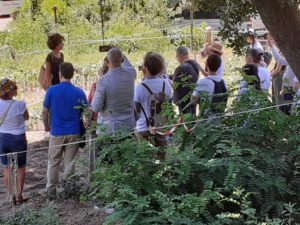
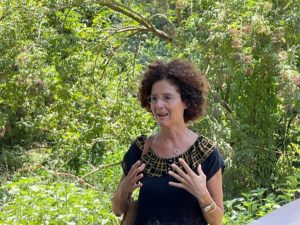
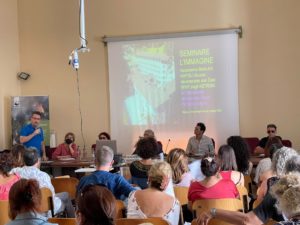
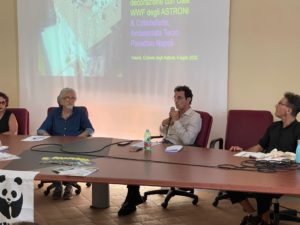
The comments of Saverio Teruzzi, Armona Pistoletto and Paolo Naldini
“This event,” said Saverio, “has been in the making for several years, since I met Professor Stefania Perna through Davide Carnevale. The encounter triggered a process that even led to a partnership between Naples’ Academy of Fine Arts and Cittadellarte. With this initiative, we wanted to highlight the importance of biodiversity in human activities”. His words were followed by those of Armona Pistoletto: “It is very rewarding to see how thanks to this art project many young people are approaching nature. Cittadellarte has been dealing with these issues for many years through the project I follow, Let Eat Bi, which I have presented to the students involved in the initiative”. Naldini closed the circle by highlighting the relevance of Sowing the Image: “Naples’ Academy of Fine Arts is a place of learning, which is crucial in this historical moment. We have to learn and re-learn everything: from our mistakes to the good things we have done. We have been to a place where we saw the sowing of an image: now, sowing the image is a challenge we cannot put off any longer. This path will lead us to truly discover a new planet: we must not go looking for it on Mars or elsewhere, we must discover it here, on our own Earth. It is a planet that we have not taken notice of except to extract resources; whereas today,” he concluded, “we can see it as a planet where we can regenerate life”.
